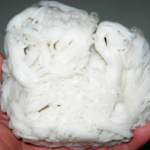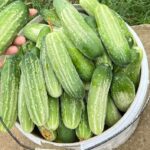How to Spot Pesticide-ridden Cucumbers
Cucumbers, eggplants, and other types of vegetables and fruits tend to contain high amounts of pesticides, so it’s best to wash them thoroughly and peel before consuming.
Cucumbers are a refreshing and healthy food item that is loved by many. However, they are often listed as one of the foods with the highest residue of harmful chemicals. To ensure consumers purchase safe cucumbers, here are some tips to keep in mind.

Wash cucumbers before consuming to ensure food safety.
– The stem end stays fresh for longer: The stem end of the cucumber is sprayed with more pesticides, so it tends to stay fresh for a longer period. Even if you leave it for a week, the stem end will remain fresh while the inside of the cucumber may turn soggy. On the other hand, a home-grown cucumber without pesticides will start to turn yellow after a few days.
– Avoid buying cucumbers that are too straight or swollen in the middle: Naturally grown cucumbers tend to be slightly curved due to their climbing nature, sunlight, temperature, and other factors. Straight cucumbers may have been artificially altered, so it’s best to choose slightly curved ones to avoid any unpleasant odors.
– Observe the thin white coating: Cucumbers that are harvested without excessive pesticides will have a thin white coating on their surface. However, if a cucumber has been sprayed with growth stimulants, this coating will be absent.
– Pay attention to the color: When choosing a cucumber, look for a deep green color. Naturally grown cucumbers tend to have a darker shade due to more sunlight exposure during their growth. Greenhouse-grown cucumbers, on the other hand, have lighter colors due to less sunlight exposure. Avoid choosing cucumbers with hormones.
– Cucumber sap: Clean, pesticide-free cucumbers will have a sticky sap that turns milky white when wiped. Cucumbers with high pesticide content will have less sap and more water, and the sap will only be slightly whitish, similar to bird’s nest water.

Washing cucumbers to remove pesticides
Given the serious concerns about food safety, it is crucial to properly wash vegetables and fruits before consumption. By following the right steps, homemakers can almost completely eliminate bacteria, pesticides, and growth stimulants from the surface of these produce. However, soaking and rinsing may not remove all toxins if they have penetrated the inside of the produce. Therefore, consumers should prioritize choosing produce with guaranteed sources.
Step 1: Remove any damaged parts and soil or sand residue.
Step 2: Soak each type of produce separately, as soaking times vary.
Step 3: Rinse under running water for the recommended duration for each type of produce.
Step 4: Peel if necessary.
– Specifically, for cucumbers, soak them in clean water for 15-30 minutes, then rinse each cucumber under running water for at least 30 seconds.
– A useful tip is to use rice washing water to neutralize the harmful chemicals in pesticides.
– Alternatively, you can use warm water to soak the produce, which will help remove most toxins from the surface.
– Peeling: For produce with high pesticide content, such as cucumbers, eggplants, carrots, and bell peppers, it is best to peel them after washing to remove more than 96% of the pesticide residue.

Some tips for long-term cucumber storage
– Keep them in a dry place: It is recommended to store cucumbers in a clean and dry environment.
– Do not peel beforehand: Another way to extend the shelf life of cucumbers is to avoid peeling or cutting them before storage. This will prevent them from spoiling quickly.
– Use paper bags or newspaper: Place cucumbers in paper bags or wrap them in newspaper and store them in a cool, well-ventilated area. Avoid damp, hot, and sunny conditions.
– Use plastic bags in the refrigerator: After wrapping each cucumber in a paper towel, place them in a plastic bag, leaving it partially open to allow air circulation. Store the bag in the lowest compartment of the refrigerator. If using a plastic container with a flip-top lid, keep the lid open to allow the cucumbers to breathe.
According to Nguoiduatin
The Secret to Detecting Chemically-Enhanced Noodles Lies in a Few Drops of Fish Sauce
Introducing a unique and effective way to identify clean and chemical-free rice noodles. While we often rely on visual cues to determine the quality of rice noodles, there is a clever trick that utilizes fish sauce. This simple yet ingenious method will revolutionize the way we assess the freshness and safety of our favorite delicacy.
The Secret to Spotting Chemically Sprayed Vegetables
Introducing the art of discerning the true nature of vegetables: just because they look good, doesn’t mean they are nutritious and safe to consume. Uncover the secrets to identifying chemical-ridden produce and take control of your health today. Learn how to separate the wheat from the chaff, or rather, the chemical-free greens from the rest. It’s time to become a vegetable connoisseur and ensure a healthier, happier you.



































